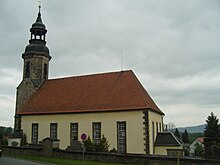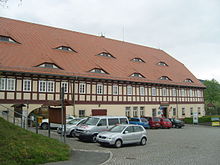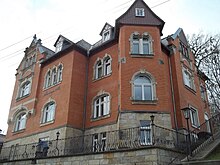Waltersdorf (Großschönau)
|
Waltersdorf
Community Großschönau
Coordinates: 50 ° 52 ′ 12 ″ N , 14 ° 39 ′ 10 ″ E
|
|
|---|---|
| Height : | 392 (360-570) m |
| Area : | 8.82 km² |
| Residents : | 1379 (Aug 31, 2008) |
| Population density : | 156 inhabitants / km² |
| Incorporation : | January 1, 2003 |
| Postal code : | 02799 |
| Area code : | 035841 |
|
View over Waltersdorf to Lausche
|
|
Waltersdorf ( Upper Lusatian : Waalerschdurf ) is a district of the Saxon community Großschönau in the district of Görlitz . The place with 1418 inhabitants is located eleven kilometers southwest of Zittau at the foot of the Lausche , the highest mountain in the Zittau Mountains and is characterized by its half-timbered houses .
geography
Waltersdorf extends over a length of 3.3 km in the valley of the Waltersdorfer Dorfbach from the border with the Czech Republic to the north. The southernmost point is the one at the pass between Lausche and Sonneberg at 571.2 m above sea level. M. located guard at which there is a border crossing for hikers to the neighboring Myslivny (Jägerdörfel). On the steeply sloping road on the northeast slope of the Lausche there are several buildings in the Sonneberg area , of which the Hubertusbaude and the Rübezahlbaude are the best known. On the western slope of the 628.5 m high Sonneberg is the oldest mountain hut in the village, the Sonnebergbaude, formerly known as Oberer Kretscham and Gasthof zur Lausche. It was first mentioned as a tavern in 1666, when Neuwaltersdorf was founded for refugees from Bohemia. The former Waltersdorfer sandstone quarries are located on the Sonneberg . The stone broken here became the building material for the numerous artistic door frames that replaced the traditional wooden door frames from 1725.
Which is in the valley between Butterberg and singer height or misfortune stone subsequent local situation Oberwaltersdorf consists largely of half-timbered houses that protect from the harsh climatic conditions with showers, before the portals grown Vorhäuschen were as snow and wind catcher provided. To the east of it is the locality of Butterberg . In the valley of flowing from the west of the Ice Passage Kohlflüßchen possible on Ottoberg the homes of new concern with the concern pond.
The northernmost part of the village is Niederwaltersdorf , which extends to the Neuschönauer Busch in the direction of Großschönau.
history
The village on the forest was probably created in the middle of the 13th century when the Zittau Mountains were settled. The first written records did not begin until 1355, and the village called Walterivilla had a church as early as 1384 . At the beginning of the 15th century there is evidence of a mill and a farm.
In 1419 the city of Zittau acquired the village from Nicolaus von Warnsdorff for a purchase price of 210 marks. Waltersdorf, which was originally part of Bohemia , came to Upper Lusatia as a council village belonging to the Zittauer Weichbild . Sandstone has been quarried on the Sonneberg since the 16th century, which was not only used as a building material, but also, as in neighboring Jonsdorf , primarily for the manufacture of millstones . Stonemasons were established in the village.
1538 Waltersdorfer silver mining that is part of the whole began Lusatian Mountains erupted Berggeschreys was that culminated in the founding of the city of St. George valley along the lines electoral Saxon mining towns found. After a dowser had examined the mountains and digged , a total of seven tunnels were driven into Lausche and Kirchberg. These were the Schwarzfärber-, the Walts Gott-, the Gesellschaft-, the Alle-Engel-, the St. Paulus-, the St. Johannis- and the St. Martins-Stolln. On Poche Bach one was Pochwerk created. Up until 1559, additional payments and the existence of a mountain clerk can be proven. Then mining came to a standstill again due to unsuccessfulness. The former mountain house was sold in 1600. Several attempts were made to revive the mining industry up to the Thirty Years War ; After the chaos of the war, Andreas Hammerschmidt resumed the search for silver in 1663, which was also unsuccessful. Apart from the bismuth excavations in the 1950s, no further mining attempts have been started.
As a result of the Upper Lusatian Pönfall Waltersdorf became Czech crown possession in 1547, until the town of Zittau bought the village back in 1554. In the 16th century new settlements were founded on Waltersdorfer Fluren. In 1557 the settlement of Saalendorf was built to the east on the road to Bertsdorf . In 1580 , Herrenwalde, west of the road to Niedergrund , followed . The recatholicization in neighboring Bohemia led to an influx of exiles , 1665 was placed above Oberwaltersdorf the local situation Neuwaltersdorf . In the same year, the linen weaving mill found its way into the town. The mushroom village was founded in 1782 .
On June 29, 1648, the Waltersdorf church was renovated and expanded in 1657. In 1713 a new building was built in the baroque style, but the church tower was retained. The church school was established a year later . In 1766, the organ builder Johannes Tamitius from Zittau replaced the old organ built in 1668 with the assistance of Andreas Hammerschmidt and consecrated it in 1769. In 1801 and 1802, the bell founder Johann Friedrich Zeißig from Saalendorf replaced two of the three church bells, the middle bell dates from 1661.
Waltersdorf has developed into a popular summer resort since the 19th century. In 1823, Carl Friedrich Matthes had a comfortable serpentine climb to the summit of the Lausche built and a managed refuge built, which soon became so popular that he expanded it in 1825 and added a bowling alley. Under his successor, a stately mountain hut was built in 1892, through which the border ran and which had a Bohemian and a Saxon taproom. The place also gained in importance as a winter sports center, in 1930 a ski jump was built and there were several downhill slopes on the southern slope of the Lausche in Bohemia.
The Saalendorfer factor Carl Gottlieb Kämmel, father of the high school teacher Heinrich Julius Kämmel , set up a jacquard weaving mill with several chairs in his house in 1827 .
The municipality of Waltersdorf was created in 1843 through the merger of the villages of Altwaltersdorf and Neuwaltersdorf. In the transition from the 19th to the 20th century, the village experienced a great boom, the old church school was replaced by a new elementary school in 1898, a post office was built in 1900 and in 1928 the municipal office moved to a new building. The gas supply began in Waltersdorf in 1890, a water pipe was built in 1905 and electricity came to the village in 1910. In 1913, the 400-year history of the Waltersdorfer sandstone quarries came to an end, the last quarry on the Sonneberg was closed.
After the Second World War , the borders with Czechoslovakia remained closed. Before that, many expelled Sudeten Germans were expelled to Germany via the border at the guard. A memorial stone on the guard reminds of this. On January 8, 1946, the hut on the Lausche was destroyed by a fire (probably deliberately set).
During the GDR era, a children's holiday camp was set up and operated by the Deutsche Post from Dresden in Waltersdorf at the foot of the Lausche. In 1956 the mill museum was established in the former middle mill. In 1968, during the invasion of Czechoslovakia, Soviet tanks rolled through the town and penetrated the neighboring country via the guard. The Lausche peak was declared a nature reserve in 1967 . After the downhill slopes of the Lausche, especially the popular slope 13, were no longer accessible due to the impermeable border, a new downhill and slalom track was created on the north slope in 1964 and a ski lift was built in 1969.
After the fall of the Wall, the traditional weaving mill went out in the village, and the last weaving mill closed in 1990. Plans to rebuild the hut on the Lausche have so far failed due to the nature conservation nature of the summit.
Place name forms
1355/72: Waltherivilla, 1419: Waltersdorff, 1483: Waltersdorff bei der Zittaw, 1554: Waltersdorff, 1875: Waltersdorf b. Großschönau
Administrative affiliation
1777: Görlitzer Kreis, 1843: Löbau District Court, 1856: Großschönau Court Office, 1875: Zittau District Authority, 1952: Zittau District, 1994: Löbau-Zittau District, 2008: Görlitz District
Population development
| year | Residents |
|---|---|
| 1547 | 22 obsessed man |
| 1777 | 13 possessed men, 29 gardeners, 259 cottagers, 10 devastation |
| 1834 | 1910 |
| 1871 | 1800 |
| 1890 | 1809 |
| 1910 | 2182 |
| 1925 | 2119 |
| 1939 | 1961 |
| 1946 | 2568 |
| 1950 | 2608 |
| 1964 | 2282 |
| 1990 | 1695 |
| 2000 | 1591 |
Local division
The districts of Herrenwalde and Saalendorf belong to Waltersdorf and are jointly represented in the community of Großschönau by a local council of nine.
Attractions
- Waltersdorf has more than 300 half-timbered houses, 230 of which are protected as monuments and most of which are decorated with ornate sandstone door frames. A special feature are the half-timbered houses in Bohemian block construction with a plank top, a type of construction that is only found in smaller numbers in German territory in Bertsdorf and Hinterhermsdorf . The Upper Lusatian Half-timbered House Waltersdorf monument trail clearly explains the peculiarities of this folk architecture.
- The center of the village is the ensemble of church and Niederkretscham. A support association was founded in 2003 to preserve the building that is threatened by decay and characterizes the townscape. The renovated Niederkretscham was expanded as a nature park house.
- The oldest mill in town, the “Mittel-Mühle” (built in 1400, dismantled as a wooden structure in 1614/15 and rebuilt in stone, wall thickness 1–1.20 meters, last reconstruction in 1861) was redesigned in 1956 as a folklore and mill museum dedicates an exhibition room to the composer Friedrich Schneider .
- In the village of Neu Sorge , a forest park was created at the Sorgeteich, the forest stage is used for events.
- Due to its location, surrounded on three sides by the mountains of the Zittau Mountains, there are numerous hiking destinations around Waltersdorf. In addition to the local mountain Lausche, these are the triangles on the pass between the Weberberg and the Finkenkoppe in Bohemia, which can be reached in the west via the Eisgasse . The Buchberg and the nearby Jonsdorf rock town rise to the east . The Lauschekamm is suitable for cross-country skiing in the winter months. On the northern slope of the Lausche, in the upper part of Waltersdorf, there is a small ski area with 3 drag lifts and a snow-making system. Another slope with a lift for skiers and snowboarders is located in the Neu Sorge district.
- As a bilateral project, the Lauschehochmoor nature trail was created on June 19, 1999 after the renaturation of the moor, mainly located in the Czech Republic, on the state border . The moor in the headwaters of the Zwittebach , which was drained by amelioration in 1988 , is located on the southeast slope of the Lausche on the way to Dolní Světlá (Nieder Lichtenwalde) and bears the Czech name Brazilka after the inn "New Brazil", which used to stand there .
- Within the village, the Waltersdorf nature trail explains the fauna and flora as well as geological features and historical settlement structures of Waltersdorf on display boards.
- There are two walking border crossings to the Czech Republic in the village. In addition to the crossing at the Wache / Stráž to Myslivny (Jägerdörfel) or Dolní Světlá (Niederlichtenwalde) there is another in the Herrenwalde district that leads to Dolní Podluží (Niedergrund). The road to Dolní Podluží is paved throughout. However, there are passage obstacles for cars.
Trivia
In 1975, the television film Sister Agnes , with Agnes Kraus in the lead role, was shot in and around the town .
Personalities
Sons and daughters of the place
- Johann Gottlob Schneider senior (1753–1840), organist and cantor
- Friedrich Schneider (1786-1853), composer
- Heinrich Julius Kämmel (1813–1881), educator, rector and member of the Frankfurt National Assembly, born in Saalendorf
- Gustav Zschierlich (1837–1925), entrepreneur and conservative politician, MdL
Other personalities
- The Zittau organist and composer Andreas Hammerschmidt worked as the administrator of the Zittau council village in the 17th century. During his tenure as lord of the village, the church received a new organ in 1668, which he helped to build.
- In 1860, Julius Lange founded a textile company in the village, which grew rapidly with the manufacture of linen articles and became the largest in Waltersdorf. The first factory building was used from 1888, and in the best of times the company premises were around two hectares in size. In 1913 it was converted into a stock corporation. The Julius-Lange-Villa (today a senior citizens' home) in Hauptstrasse 60, which was built in 1903 as a commercial building, is a reminder of the entrepreneur . The former company site behind the villa has been renatured and has been open to the public since June 21, 2015 as the “Zittauer Gebirge” nature park garden .
See also
Individual evidence
- ↑ Upper Lusatian Dictionary: Letter W. Retrieved March 22, 2013 .
- ^ Johann Benedict Carpzov : Newly opened Temple of Honor of Merckworthy Antiques of the Marggraffthum Ober-Lausitz. Leipzig u. Budissin 1719, pp. 232-233.
- ^ Waltersdorf (Großschönau) in the Digital Historical Directory of Saxony
- ↑ Information board at Villa Hauptstrasse 60
- ↑ Archived copy ( memento of the original from November 17, 2015 in the Internet Archive ) Info: The archive link was inserted automatically and has not yet been checked. Please check the original and archive link according to the instructions and then remove this notice.
- ↑ Archived copy ( memento of the original from November 19, 2015 in the Internet Archive ) Info: The archive link was inserted automatically and has not yet been checked. Please check the original and archive link according to the instructions and then remove this notice.
- ↑ http://www.naturschutzzentrum-zittau.de/tourismus/projekte/naturparkgarten-in-waltersdorf.html
literature
- The south-eastern Upper Lusatia with Zittau and the Zittau Mountains (= values of the German homeland . Volume 16). 1st edition. Akademie Verlag, Berlin 1970.
- Cornelius Gurlitt : Waltersdorf. In: Descriptive representation of the older architectural and art monuments of the Kingdom of Saxony. 29. Issue: Amtshauptmannschaft Zittau (Land) . CC Meinhold, Dresden 1906, p. 244.
- Peter Rölke (Ed.): Hiking and nature guide Zittau Mountains . Berg- und Naturverlag Rölke, Dresden 2006








